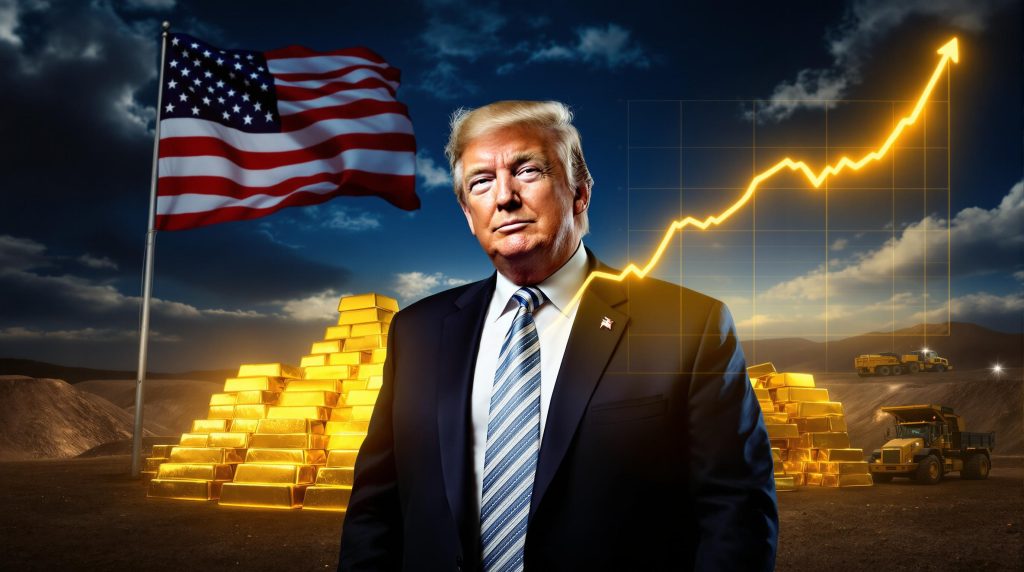How Did Trump's Gold Tariff Exemption Affect Global Bullion Markets?
The global gold market experienced significant turbulence in recent weeks following a surprising U.S. customs ruling that temporarily imposed duties on gold bars, creating ripple effects across international bullion markets. The confusion culminated in a dramatic intervention by former President Trump, who announced an exemption for gold imports from tariffs, though market volatility persisted despite the clarification.
The Surprise Customs Ruling and Market Disruption
The initial customs ruling caught traders and investors completely off guard, imposing unexpected duties on gold bars entering the United States. This sudden policy shift triggered immediate market confusion as major gold exporters, particularly Switzerland, quickly froze shipments to American buyers while seeking clarity on the new requirements.
The market impact was immediate and substantial. U.S. gold futures surged to record highs as supply uncertainties created a premium on domestically available gold. Trading volumes spiked dramatically as market participants scrambled to adjust positions amid the regulatory uncertainty.
Data shows that during this period:
- Swiss gold shipments to the U.S. virtually halted overnight
- Domestic gold premiums rose significantly above global spot prices
- Trading volatility reached levels not seen since the pandemic market turbulence
- Physical gold dealers reported unprecedented customer inquiries
As one gold market veteran noted, "The sudden implementation of duties without clear guidance created one of the most chaotic trading environments in recent memory for physical gold."
Presidential Intervention and Policy Clarification
After several days of market confusion, former President Trump made a surprise announcement declaring that gold would be exempt from tariffs. This intervention was reportedly prompted by intense lobbying from financial institutions and concerns about market stability.
The former president's statement specifically mentioned that "gold and other specialty products" would receive exemption status, though formal implementation through executive order remained pending at the time. The announcement provided some much-needed clarity to the market, but questions about the full scope and timeline of the exemption persisted.
Despite the clarification, spot gold still closed down more than 1% that day, highlighting the lingering uncertainty and the market's cautious approach to the policy reversal. This price movement reflected continued concerns about:
- The timeline for formal policy implementation
- The exact definition of "specialty products" included in the exemption
- Potential future policy changes affecting precious metals
- Procedures for shipments already in transit or held at customs
The event underscored gold's unique position at the intersection of commodity markets, monetary policy, and geopolitical considerations. Recent gold prices analysis 2025 suggests that such policy uncertainties will continue to influence market dynamics.
What Factors Drive Gold Import Policies in the United States?
Gold occupies a distinctive place in the U.S. economic landscape, with import policies typically reflecting broader strategic and financial considerations rather than standard trade balancing measures.
Strategic Importance of Gold in US Economy
Gold's role in the U.S. economy extends far beyond its commodity value. As a traditional safe-haven asset, gold serves as an essential component of the nation's financial infrastructure and plays a critical role during economic uncertainty.
The Federal Reserve holds approximately 8,133 metric tons of gold in its reserves, making it the world's largest official gold holder. This massive stockpile, valued at over $500 billion at current prices, underscores gold's continued importance in America's financial system despite the end of the gold standard decades ago.
U.S. gold import regulations have historically been designed to:
- Ensure stable supply for domestic financial institutions
- Maintain pricing consistency in domestic markets
- Support the jewelry and technology manufacturing sectors
- Provide flexibility for monetary policy operations
Unlike many imported commodities, gold rarely faces significant tariffs in normal circumstances due to its monetary characteristics. The recent tariff confusion represented a dramatic departure from long-standing U.S. policy approaches to precious metals. The Trump tariff impact extends beyond gold to various sectors of the economy.
International Trade Relationships and Gold Flows
The United States relies heavily on gold imports to meet domestic demand, with Switzerland, the United Kingdom, and Canada serving as the primary sources. These import relationships reflect complex global refining and trading networks rather than simple bilateral exchanges.
Switzerland holds particular importance, with its highly regarded refineries processing gold from mining operations worldwide before shipping investment-grade bars to U.S. markets. This supply chain interdependence explains why the brief tariff confusion created such immediate market disruption.
Gold import policies also intersect with broader international monetary cooperation:
"Gold remains the ultimate form of payment in the world. Fiat money in extremis is accepted by nobody. Gold is always accepted." – Former Federal Reserve Chairman Alan Greenspan
Trade relationships in the gold sector differ significantly from other commodities, with considerations extending beyond simple economic calculations to include:
- Central bank cooperation and monetary stability
- Financial system resilience during crisis periods
- International reserve asset management
- Long-standing bullion market traditions and expectations
This complex web of considerations explains why the recent tariff confusion triggered such immediate and dramatic market responses, and why presidential intervention came so quickly. Analysts reviewing the gold price forecast 2025 point to trade policy as a key factor in future price movements.
How Do Tariff Policies Impact Global Mining Operations?
Mining operations worldwide remain highly sensitive to trade policy changes, with tariffs capable of reshaping project economics, supply chains, and investment decisions. Two recent cases highlight how regulatory and market conditions affect major mining enterprises.
Case Study: El Teniente Copper Mine Recovery
Chile's El Teniente copper mine, one of the world's largest underground copper operations, has successfully restored 82% of its production capacity following a catastrophic collapse on July 31st that killed six workers and damaged approximately 3,700 meters of tunnels. The rapid recovery demonstrates both the resilience of major mining operations and the critical importance of copper supply continuity to global markets.
The mine's owner implemented a comprehensive "safe and gradual return plan" that prioritized worker safety while systematically restoring production. Within just over a week after the accident:
- Eight underground mining areas resumed operations
- The facility's smelter returned to normal functioning
- New safety protocols were implemented across all operations
- An interim leadership team was installed following the replacement of the mine's chief
This swift recovery proved crucial for global copper markets, as El Teniente represents a significant portion of Chile's copper output. The response demonstrates how major mining operations balance safety considerations with the economic imperative to maintain production levels, particularly during periods of strong copper demand and tight global supply.
Luxury Goods Market: Gemfields and Fabergé
In a stark contrast to El Teniente's operational recovery, Gemfields Group's recent sale of luxury jewelry brand Fabergé illustrates how market conditions can dramatically impact mining company investment strategies. Gemfields sold Fabergé to U.S. investment firm SMG Capital for $50 million—a staggering $92 million loss from its 2013 purchase price of $142 million.
This substantial write-down reflects:
- Revenue decline from $15.7 million in 2023 to $13.4 million in the current year
- Broader weakness in the luxury goods market affecting gemstone demand
- Regional unrest in Mozambique affecting Gemfields' core mining operations
- Strategic refocusing on primary mining activities amid challenging market conditions
Gemfields' experience highlights how mining companies often struggle to successfully integrate downstream luxury product lines, despite the apparent strategic logic of controlling more of the value chain. The significant financial loss underscores the challenges of operating in both the extractive and luxury retail sectors simultaneously.
The case also demonstrates how tariff and trade policy uncertainties can compound existing market challenges for companies with complex international supply chains spanning multiple regulatory environments.
What's Happening in the Global Lithium Market?
The lithium market is experiencing renewed volatility following significant supply disruptions in China, the world's dominant producer of this critical battery material. Recent developments suggest potentially tighter supply conditions after months of oversupply concerns.
Supply Disruption: CATL's Yichun Mine Closure
Contemporary Amperex Technology Co. (CATL), the world's largest electric vehicle battery manufacturer, recently suspended operations at its Yichun lithium mine in China's Jiangxi Province due to an expired mining permit. This disruption represents a significant supply shock, as the Yichun operation accounts for approximately 6% of global lithium production.
The closure's market impact was immediate and substantial:
- Lithium futures for Chinese producer Ganfeng hit the 8% daily limit increase
- Stocks of major lithium producers surged on expectations of tightening supply
- Analysts quickly revised price forecasts upward after months of bearish sentiment
- EV manufacturers began reassessing supply chain vulnerabilities
Market speculation intensified around the true cause of the closure, with some industry observers suggesting it might represent more than a simple permit issue. Reports indicate Beijing may be implementing broader measures to control industrial overcapacity in the lithium sector, potentially suspending additional projects in coming months.
Market Response to Supply Constraints
The lithium market's reaction to the Yichun closure reveals the sector's continued fragility despite recent price declines from 2022's record highs. Lithium prices had fallen approximately 80% from peak levels due to significant new production capacity and some demand softening in China's EV market.
CATL quickly issued statements assuring customers that its battery production would remain unaffected despite the mining disruption, highlighting the company's diverse supply sources. However, market analysts noted several important implications:
- The swift price response suggests lithium's supply-demand balance remains tighter than commonly believed
- China maintains overwhelming control of global lithium processing capacity regardless of mining locations
- Regulatory decisions in China can create immediate global market impacts
- Supply chain redundancy has become a critical priority for battery manufacturers
The situation demonstrates how rapidly evolving regulatory environments can create unexpected supply constraints in critical mineral markets, with implications extending throughout electric vehicle and energy storage supply chains. Investors evaluating gold market strategies often consider these related commodity markets when assessing portfolio allocations.
How Are Major Mining Projects Securing Financing?
Financing arrangements for major mining projects have grown increasingly complex as geopolitical considerations, ESG requirements, and shifting market conditions reshape traditional funding approaches. The Reko Diq project in Pakistan provides a fascinating case study in modern mining finance.
Barrick Gold's Reko Diq Project Funding Strategy
Barrick Gold is actively pursuing approximately $3.5 billion in international financing for its massive $9 billion Reko Diq copper-gold project in Pakistan. This funding strategy involves engaging a diverse coalition of international lenders after the collapse of a previously anticipated Saudi investment.
According to Barrick CEO Mark Bristol, the company is in discussions with:
- International Finance Corporation (IFC)
- U.S. Export-Import Bank
- Asian Development Bank
- German development bank KfW
- Canadian and Japanese financial institutions
The project's scale and location make it a particularly challenging financing proposition. Located in Pakistan's remote Balochistan province, Reko Diq represents one of the world's largest undeveloped copper-gold deposits, with production expected to commence in 2028.
The complexity of the financing effort reflects both the enormous capital requirements and the project's strategic importance in an increasingly competitive global mining landscape.
Strategic Implications of International Investment
The financing structure for Reko Diq carries significant geopolitical implications beyond simple project economics. U.S. government backing through the Export-Import Bank would potentially secure American access to copper concentrate at a time of growing competition for critical minerals.
However, several challenges remain:
- Pakistan's shortage of domestic smelting capacity presents logistical hurdles
- The project's remote location necessitates substantial infrastructure development
- Regional security concerns require robust risk mitigation strategies
- International lending standards impose stringent environmental and social requirements
Bristol noted that the comprehensive financing package is coming together despite these challenges, highlighting the project's compelling economics and strategic importance. When operational, Reko Diq will significantly increase global copper supply at a time when electrification trends are driving unprecedented demand growth.
The financing approach demonstrates how major mining projects increasingly rely on complex international funding consortiums rather than traditional single-source capital arrangements, reflecting both the enormous scale of modern developments and their strategic importance to multiple nations.
FAQs About Gold Imports and Tariffs
How do tariffs typically affect precious metal prices?
Tariffs on precious metals generally create immediate price dislocations between markets, though long-term impacts vary based on policy specifics. When tariffs are imposed, several patterns typically emerge:
- Domestic prices rise above global spot prices by approximately the tariff percentage
- Trading volumes surge as market participants reposition holdings
- Physical delivery premiums increase substantially in affected markets
- Arbitrage opportunities emerge between different jurisdictions
Historical examples show that markets eventually adjust through supply chain reconfiguration, but short-term volatility can be extreme. The gold market's recent reaction to tariff confusion demonstrates the sensitivity of precious metals to policy uncertainty. According to a Reuters report, markets reacted immediately to Trump's clarification on gold tariffs.
What determines which commodities receive tariff exemptions?
Exemption decisions typically reflect a complex mix of strategic, economic, and political considerations. For precious metals like gold, exemption factors often include:
- Monetary and financial system implications
- Manufacturing industry requirements for consistent supply
- Trade balance considerations and reciprocity agreements
- National security and strategic stockpile requirements
Gold's exemption reflects its unique status as both a commodity and a monetary asset. Unlike industrial metals, gold's role in financial markets and central bank reserves gives it special consideration in trade policy decisions.
How do mining companies adapt to changing trade policies?
Mining operations implement several strategies to navigate policy uncertainty:
- Geographic diversification of processing facilities across multiple jurisdictions
- Flexible sales contracts with provisions for regulatory changes
- Strategic stockpiling at key distribution points
- Forward hedging to lock in prices during uncertainty periods
Companies also increasingly engage in scenario planning to anticipate potential policy shifts. The most sophisticated operators maintain alternative supply chain configurations that can be quickly implemented when trade conditions change.
Key Takeaways on Gold Imports and Global Mining
Market Sensitivity to Regulatory Changes
The recent gold tariff confusion demonstrates the extreme sensitivity of commodity markets to regulatory uncertainty. Even temporary policy confusion can trigger significant price movements, supply disruptions, and trading volatility.
Key observations from recent events include:
- Market participants react almost instantly to policy announcements affecting major commodities
- Price premiums emerge immediately in jurisdictions facing supply constraints
- International supply chains can freeze within hours of regulatory uncertainty
- Clear policy communication proves essential for market stability
These patterns extend beyond gold to other critical minerals, as evidenced by the dramatic price response to China's lithium mining permit decisions. In both cases, regulatory clarity—or its absence—drove immediate and substantial market movements.
Interconnected Nature of Global Mining Markets
Recent events highlight the increasingly interconnected nature of global mining and mineral markets. Disruptions in one region or commodity sector quickly cascade through related markets:
| Event | Market Impact | Policy Response |
|---|---|---|
| Gold tariff confusion | US futures at record highs | Presidential exemption announcement |
| El Teniente mine collapse | Production reduced to 82% | Safety-focused gradual return plan |
| Fabergé sale by Gemfields | $92M loss from purchase price | Financial restructuring strategy |
| CATL's Yichun mine closure | 8% price jump in lithium futures | Speculation about broader capacity controls |
| Reko Diq financing pursuit | $3.5B international funding target | Multi-national lender engagement |
These interconnections create both risks and opportunities for market participants. Understanding these linkages has become essential for investors, producers, and policymakers navigating increasingly complex global mineral markets. Investors should also consider the gold-silver ratio insights when evaluating precious metals exposure.
Expert Insight: Trade policy decisions on precious metals often reflect broader economic strategies beyond the immediate commodity market, affecting everything from monetary policy to industrial supply chains.
Future Outlook for Mining Investment and Trade Policy
The mining sector faces a period of significant transition as energy transformation technologies drive unprecedented demand for critical minerals while regulatory environments grow increasingly complex. Several key trends will likely shape the industry's future:
- Geopolitical considerations will increasingly influence mining investments and trade policies
- Supply chain resilience will command premium valuations from investors and customers
- Regulatory transparency will become a competitive advantage for mining jurisdictions
- Processing capacity will emerge as a strategic chokepoint in critical mineral supply chains
- International financing consortiums will become standard for major development projects
These trends suggest mining companies must develop sophisticated regulatory navigation capabilities alongside traditional operational excellence. The ability to anticipate and adapt to policy changes—as demonstrated in the gold tariff case—may prove as valuable as geological expertise in determining future mining success.
As global competition for critical minerals intensifies, the intersection of trade policy and mining economics will remain a crucial focus for industry leaders, investors, and policymakers alike. According to CNBC analysis, the gold market's reaction to trade policy changes demonstrates the metal's continued importance in global financial systems.
Want to Be First to Capitalise on Major Mineral Discoveries?
Discovery Alert's proprietary Discovery IQ model delivers real-time notifications when significant mineral discoveries are announced on the ASX, empowering you to act before the broader market responds. Explore how historic discoveries have generated substantial returns by visiting our dedicated discoveries page and position yourself ahead of the market.




